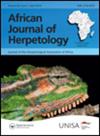Genetic diversity of the mantellid frog Blommersia blommersae, and description of a new anuran species from south-eastern Madagascar
IF 0.9
4区 生物学
Q3 ZOOLOGY
引用次数: 1
Abstract
ABSTRACT A range-wide assessment of genetic variation in one mitochondrial (16S rRNA) and one nuclear-encoded (Rag-1) gene fragment of the widespread Madagascar frog Blommersia blommersae revealed the presence of up to 12 deep genetic lineages. Many of these differed by genetic distances >3% in the 16S gene. In the Ranomafana area in the southern central east of Madagascar, two mitochondrial lineages differing by 1.2–1.8% in 16S occurred in close syntopy across multiple sites. A phylogeny of representative samples based on multiple mitochondrial genes supported three main mitochondrial clades within B. blommersae, with lineages from the (i) north, (ii) north and northern central east, and (iii) southern central east, respectively. In addition, one lineage from Sainte Luce in the south-east was sister to all other species of Blommersia, and thus clearly not belonging to B. blommersae, to which it has been tentatively assigned previously. Except for the Sainte Luce population, most of the mitochondrial lineages did not show a concordant and consistent differentiation in Rag-1 and no obvious morphological differences were detected among the lineages. We therefore refrain from taxonomic conclusions for them at this time, although indications exist that the populations from the northern central east and southern central east may show certain differences in relative note duration of advertisement calls, which require further study. However, the Sainte Luce individuals were highly divergent in 16S (>10%) and Rag-1, phylogenetically isolated, and characterised by differences in colour pattern. This lineage represents the most evolutionarily divergent species of Blommersia known to date and is herein formally named and described as Blommersia dupreezi sp. nov.马达加斯加东南部斑点蛙的遗传多样性和一个新的无尾蛙种的描述
摘要对广泛分布的马达加斯加蛙Blommersia blommersae的一个线粒体(16S rRNA)和一个核编码(Rag-1)基因片段的遗传变异进行了广泛的评估,发现存在多达12个深层遗传谱系。其中许多在16S基因中的遗传距离大于3%。在马达加斯加中南部东部的拉诺马法纳地区,两个16S中差异1.2-1.8%的线粒体谱系在多个位点之间存在紧密的同源性。基于多个线粒体基因的代表性样本的系统发育支持B.blommersae内的三个主要线粒体分支,其谱系分别来自(i)北部、(ii)北部和中北部东部以及(iii)中南部东部。此外,东南部圣卢斯的一个谱系是Blommersia所有其他物种的姐妹,因此显然不属于B.blommersae,此前已将其暂定为该物种。除Sainte-Luce群体外,大多数线粒体谱系在Rag-1中没有表现出一致和一致的分化,并且在谱系之间没有检测到明显的形态学差异。因此,尽管有迹象表明,来自中东部北部和中东部南部的种群可能在广告呼叫的相对音符持续时间上表现出一定的差异,但我们目前还没有对它们得出分类学结论,这需要进一步研究。然而,Sainte-Luce个体在16S(>10%)和Rag-1上高度分化,在系统发育上是孤立的,其特征是颜色模式的差异。该谱系代表了迄今为止已知的最具进化差异的Blommersia物种,并在本文中正式命名和描述为Blommersia duplizei sp.nov。
本文章由计算机程序翻译,如有差异,请以英文原文为准。
求助全文
约1分钟内获得全文
求助全文
来源期刊

African Journal of Herpetology
ZOOLOGY-
CiteScore
3.00
自引率
6.70%
发文量
15
审稿时长
>12 weeks
期刊介绍:
African Journal of Herpetology (AJH) serves as an outlet for original research on the biology of African amphibians and reptiles. AJH is an interdisciplinary journal that publishes original articles and reviews from diverse fields and disciplines, such as conservation, phylogenetics, evolution, systematics, performance, physiology, ecology, behavioural ecology, ethology, and morphology.
The Journal publishes two issues a year. There are no page charges .
 求助内容:
求助内容: 应助结果提醒方式:
应助结果提醒方式:


